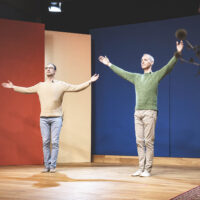For 100 years, the founding moment of the Anthroposophical Society and School for Spiritual Science has been called “The Christmas Conference.” It was a conference at Christmas, but it was not only that—it was also a Christmas conference that signaled a beginning.
The title of the last day of our conference was “A Beginning, A Real Beginning of Life.”1 With that statement, Rudolf Steiner emphasized that the Christmas Conference heralded a primal beginning. Every year at Christmas, there is a new beginning. In this sense, the conference was most certainly a Christmas Conference, and it can continue to exist as one if the will is there. The Christmas Conference of that time has carried the Anthroposophical Society and the incipient School for Spiritual Science through the century with great strength. Whether it remains meaningful after 100 years is in today’s hands; it is today’s responsibility. It can live on and be an ever-new Christmas Conference—at Christmas or perhaps at any time of year.
Today, the Anthroposophical Society is a world society. It lives in many countries on Earth. We had forty countries represented at this year’s conference. It lives in many other places, and it lives in different languages. It is audible; it is understandable in many languages of the world. Anthroposophy was translated rapidly and emerged anew in various languages. The philosopher Franz Rosenzweig said that once something has been translated, it can no longer be cut off from the world. In fact, anthroposophy lives in the most diverse cultures, in the most diverse linguistic areas. This means that it can be read, heard, and spoken. That is a reality.
I believe that the question for the future is not whether anthroposophy is alive in the world—it lives—but whether the institutions and the places where it is working in the most varied fields of life can continue to exist and how they can continue to exist—that is what is called into question. Schools and farms are threatened; it is an open question whether they can survive, whether, in ten years, in twenty years, they will still be there. Where will the children of a school go if the school no longer operates? Who is awake to co-responsibility? Who has interest? Who in the Society is seeking active engagement with these institutions?
The Goetheanum Lives Through Interest
Today, a growing interest and awareness of this task is present in the Anthroposophical Society. This awakeness, this participation, is being called for by the future. What is asked for is the perception of concrete responsibility for where we live and work. Anthroposophical work includes the National Societies and the groups in each country. One can only know what is right for a Waldorf school or for a Demeter farm from a local perspective, on-site. It is not possible to say what is good from afar. It is not the task of the School for Spiritual Science to intervene in an institution somewhere. The Society can make it its task to support the institutions, and the Society, as a cosmopolitan world society, does have the task of taking responsibility for an institution that is a visibly manifested place of anthroposophy. That is the Goetheanum: a collaborative place of the Society.
The Goetheanum needs interest and engagement—in this building and with all the human beings who work here, the 200 co-workers who contributed to making this year’s conference possible. The existence of this place and its work is not secured by itself. During the Corona time, the Goetheanum had to be temporarily closed. How does a public place live that no one can visit? Or if the question arises, how can it continue to work? How does one carry this place? There is a shared responsibility for this Goetheanum across the world. This will also be necessary in the coming years. It cannot be affirmed or even assured for the next hundred years, but it can for the next five years, for the next twenty years. We can strive for fellowship with this task with active interest in what anthroposophy brings directly to the public, where it becomes effective. For that, in the spirit of Christmas, one wishes that, ever anew, good may become.
Translation Joshua Kelberman
Photo Constanza Kaliks (center) with Marion Debus (left) and Justus Wittich (right). Photo Source: Ariel Turner.





